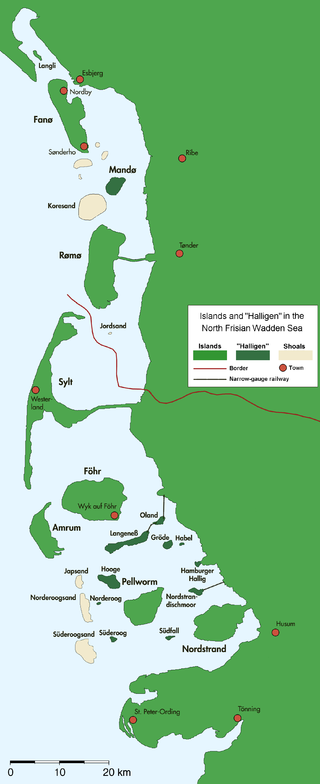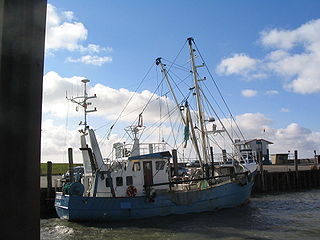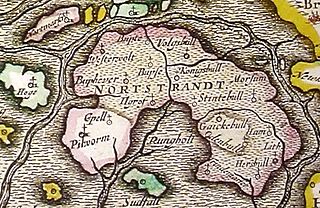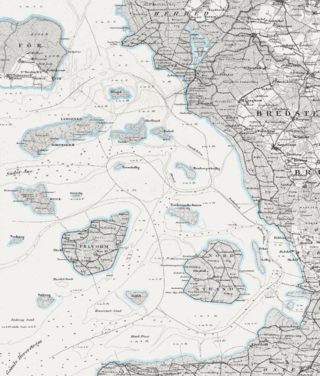
Nordfriesland, also known as North Frisia, is the northernmost district of Germany, part of the state of Schleswig-Holstein. It includes almost all of traditional North Frisia, as well as adjacent parts of the Schleswig Geest to the east and Stapelholm to the south, and is bounded by the districts of Schleswig-Flensburg and Dithmarschen, the North Sea and the Danish county of South Jutland. The district is called Kreis Nordfriesland in German, Kreis Noordfreesland in Low German, Kris Nordfraschlönj in Mooring North Frisian, Kreis Nuurdfresklun in Fering North Frisian and Nordfrislands amt in Danish.

The North Frisian Islands are the Frisian Islands off the coast of North Frisia.

Husum is the capital of the Kreis (district) Nordfriesland in Schleswig-Holstein, Germany. The town was the birthplace of the novelist Theodor Storm, who coined the epithet "the grey town by the sea". It is also the home of the annual international piano festival Raritäten der Klaviermusik founded in 1986.

Föhr is one of the North Frisian Islands on the German coast of the North Sea. It is part of the Nordfriesland district in the federal state of Schleswig-Holstein. Föhr is the second-largest North Sea island of Germany and a popular destination for tourists. A town and eleven distinct municipalities are located on the island. The climate is oceanic with moderate winters and relatively cool summers.

is a peninsula and former island in North Frisia on the North Sea coast of Germany. It is part of the Nordfriesland district in the federal state of Schleswig-Holstein. Its area is 50 km² and its population is 2,300. Nordstrand has two municipalities, Nordstrand and smaller Elisabeth-Sophien-Koog, which are part of the Amt Nordsee-Treene.

North Frisian is a minority language of Germany, spoken by about 10,000 people in North Frisia. The language is part of the larger group of the West Germanic Frisian languages. The language comprises 10 dialects which are themselves divided into an insular and a mainland group.

Dagebüll is a municipality located at the west coast of Schleswig-Holstein in the Nordfriesland district, Germany. Today's Dagebüll was created in 1978 as a merger of the municipalities of Fahretoft, Juliane-Marien-Koog and Waygaard. Dagebüll used to be a Hallig, the oldest houses were built on artificial dwelling hills which in parts can still be seen today. In 1704 the area was secured by sea dikes.

Mandø or Manø is one of the Danish Wadden Sea islands off the southwest coast of Jutland, Denmark in the Wadden Sea, part of the North Sea. The island covers an area of 7.63 square kilometres and had between 27-31 inhabitants in January 2022. The island is part of Esbjerg Municipality and is situated approximately 12 kilometres southwest of the ancient town of Ribe.

Tönning is a town in the district of Nordfriesland in the German state of Schleswig-Holstein.

The Burchardi flood was a storm tide that struck the North Sea coast of North Frisia, Dithmarschen and southwest Jutland on the night between 11 and 12 October 1634. Overrunning dikes, it shattered the coastline and caused thousands of deaths and catastrophic material damage. Much of the island of Strand washed away, forming the islands Nordstrand, Pellworm and several halligen.

Strand was an island on the west coast of Nordfriesland in Schleswig, which was a fiefdom of the Danish crown. The area now belongs to Schleswig-Holstein in northern Germany.

North Frisia is the northernmost portion of Frisia, located in Schleswig-Holstein, Germany, between the rivers Eider and Wiedau. It also includes the North Frisian Islands and Heligoland. The region is traditionally inhabited by the North Frisians.

Hattstedt is a municipality in the district of Nordfriesland, in Schleswig-Holstein, Germany. It is situated near the North Sea coast, approx. 6 km northwest of Husum. Located on the edge of the village is the Mikkelberg-Kunst-und-Cricket Center, a cricket ground which has in the past held neutral Women's One Day Internationals between Denmark Women and the Netherlands Women.
Eidum or Eydum was a historic place on the German island of Sylt in the North Sea. It was several hundred metres west of the present coast line of the present-day village of Westerland.

Uthlande, Utlande is a term for the islands, halligen and marshes off the mainland of North Frisia in the Southwest Jutland, modern Nordfriesland district, Germany.
Strand Frisian was a dialect of the North Frisian language which was originally spoken on Strand island, Duchy of Schleswig. Strand was destroyed in the Burchardi flood of 1634 with its remnants forming the islands Pellworm and Nordstrand which are now part of Germany. Strand Frisian is counted among the mainland group of North Frisian dialects.

Hainshallig was a small Hallig in the North Frisian Wadden Sea, located east of the Hallig of Hooge, that was flooded and sank in 1860. At the time, Hainshallig was leased to a Hooge resident as part of a leasehold estate and was used for the production of hay. A levee may have once led from Hooge to Hainshallig. The area belonged to the Duchy of Schleswig, which was a fiefdom of the Danish crown, now Germany.

Beltring Hundred was a mediaeval hundred located in the southern part of North Frisia in the Danish region of Southern Schleswig, part of the Frisian Uthlande. It encompassed the northern part of the island of Strand, which sank in 1634 during the Burchardi flood. Some of the land of Beltring Hundred survived the flood, however, and became the Hallig of Nordstrandischmoor as well as the site of the modern municipality of Ockholm. Beltring Hundred was one of the so-called Five Hundreds or Strand Hundreds on the island, the others being Edoms Hundred, Pellworm Hundred, Southern Goes Hundred, and Lundenberg Hundred.

Pellworm Hundred was a mediaeval hundred located in the southern part of North Frisia in the Danish region of Southern Schleswig, part of the Frisian Uthlande. It encompassed the western part of the island of Strand, which sank in 1634 during the Burchardi flood. Pellworm Hundred was one of the so-called Five Hundreds or Strand Hundreds on the island, the others being Edoms Hundred, Beltring Hundred, Southern Goes Hundred, and Lundenberg Hundred. The land that remained of the hundred after the flood is now largely geographically part of the modern island of Pellworm in the German state of Schleswig-Holstein.

Lundenberg Hundred was a mediaeval hundred located in the southern part of North Frisia in the Danish region of Southern Schleswig, part of the Frisian Uthlande. Lundenberg Hundred was one of the so-called Five Hundreds or Strand Hundreds on the island, the others being Edoms Hundred, Beltring Hundred, Southern Goes Hundred, and Pellworm Hundred. It encompassed the southeastern part of the former island of Strand, between what are now the peninsulae of Nordstrand and Eiderstedt.
















